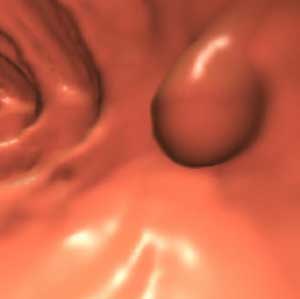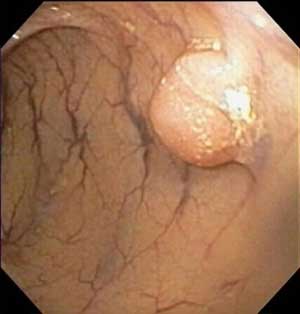RSNA Press Release
- 3-D virtual colonoscopy is as sensitive as conventional colonoscopy in screening average-risk patients.
- 3-D virtual colonoscopy provides a "movie" of the colon's interior.
- Virtual colonoscopy is less costly, less invasive and less time-consuming than conventional colonoscopy.
3-D Virtual Colonoscopy is as Sensitive as Conventional Procedure
Released: December 1, 2003
|
Media Contacts: |
Heather Babiar or Maureen Morley | (630) 590-7762 |
|
Heather Babiar (630) 590-7738 hbabiar@rsna.org |
Maureen Morley (630) 590-7754 mmorley@rsna.org |
CHICAGO — Three-dimensional computed tomography (CT) colonography, also known as virtual colonoscopy, is as sensitive as and less invasive than conventional colonoscopy in screening average-risk patients, according to research presented today at the 89th Scientific Assembly and Annual Meeting of the Radiological Society of North America (RSNA). The new technology allows radiologists to obtain 3-D images from different angles, providing a "movie" of the interior of the colon without having to insert a scope.
"I believe virtual colonoscopy will eventually join conventional colonoscopy as a major component of colorectal cancer screening in the U.S.," said lead author Perry J. Pickhardt, M.D., currently an associate professor of radiology at University of Wisconsin Medical School in Madison. This prospective multicenter trial was conducted at the National Naval Medical Centers in Bethesda, Md., the Naval Medical Center in San Diego, and at Walter Reed Army Medical Center (Walter Reed) in Washington, D.C.
Colon polyps are benign growths that may develop into colon cancer if not removed. Many people resist screening because of the discomfort caused by conventional colonoscopy and other tests.
"The goal of screening with virtual colonoscopy is to increase the number of patients that would participate," said co-author Lieutenant Colonel J. Richard Choi, Sc.D., M.D., principal investigator of the Virtual Colonoscopy Screening Project at Walter Reed. "Even though colorectal cancer is the second leading cause of cancer death and is almost always preventable, less than half of eligible patients undergo any form of screening."
In recent years, radiologists have begun using CT colonography to screen for colon polyps. Although less invasive, until now the procedure primarily used 2-D CT slices (images) for polyp detection, which are likely less sensitive.
With the addition of 3-D "fly-through" images, virtual colonoscopy provides the complete picture, creating precise and detailed images of the interior of the colon in a minimally invasive manner.
With virtual colonoscopy, there is no risk of bleeding or of perforating the colon. There is no need for intravenous sedation, and the procedure is less costly than conventional colonoscopy. It also is more convenient, taking 15 minutes or less, because patients need not recover from sedation.
For this study, Dr. Pickhardt, Dr. Choi and colleagues performed both conventional and virtual colonoscopy on 1,233 asymptomatic adults, 97.4 percent of whom were at average risk of having colonic polyps. Overall, virtual colonoscopy detected more than 90 percent of significant polyps. For example, virtual colonoscopy detected 92.6 percent of polyps 8 mm and greater, whereas conventional colonoscopy detected 89.5 percent of such polyps. Two malignant polyps were present, and virtual colonoscopy detected both of them, while conventional colonoscopy missed one.
"This minimally invasive total colonic examination compares favorably
with conventional colonoscopy for detection of clinically relevant lesions,"
Dr. Pickhardt said.
Most polyps that are missed by virtual colonoscopy are small (5 mm or less)
and are of little or no clinical importance, according to Dr. Pickhardt. Virtual
colonoscopy is able to identify occasional polyps that are located behind folds
in the colon lining and may be missed by conventional colonoscopy.
"Virtual colonoscopy also sees beyond the inner lining of the colon to the muscular layer and the colon's outer surface and can be used to check for evidence of enlarged lymph nodes around the colon, which may indicate advanced, more invasive forms of cancer," Dr. Choi said.
"The findings of this study should establish virtual colonoscopy as a viable screening option," Dr. Pickhardt said. "This less invasive screening option will likely encourage more adults to seek testing, resulting in many additional lives saved." A recent commentary in the Journal of the American Medical Association (JAMA) advised that colon screening with any test is recommended for anyone over the age of 50.
According to Dr. Choi, as a result of this study, Walter Reed is now offering virtual colonoscopy as an alternative to conventional colonoscopy screening.
RSNA is an association of more than 35,000 radiologists, radiation oncologists
and related scientists committed to promoting excellence in radiology through
education and by fostering research, with the ultimate goal of improving patient
care. The Society is based in Oak Brook, Ill.
 |
|
|
Fig 1A: Map of the air-filled colon that is automatically generated from the CT scan by the virtual colonoscopy software. The green line represents the automated centerline for virtual navigation through the colon. |
|
 |
|
|
Fig 1B: Virtual colonoscopy image of an 8-mm polyp detected in a patient undergoing routine screening. This image is generated from the noncontrast CT scan. |
|
 |
|
|
Fig 1C: Image from subsequent conventional colonoscopy shows the same polyp seen in figure 1B. |
Play video clip:
Virtual colonoscopy flight through a portion of the colon shows a 9-mm polyp protruding into the colonic lumen. (.avi file, 16 seconds)
# # #
 PDF
PDF